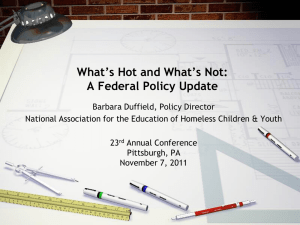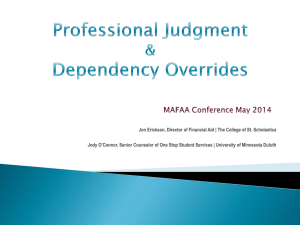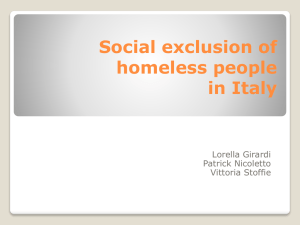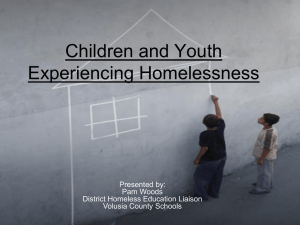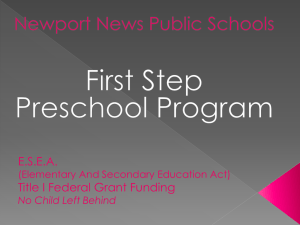What`s Hot and What`s Not: A Federal Policy Update
advertisement
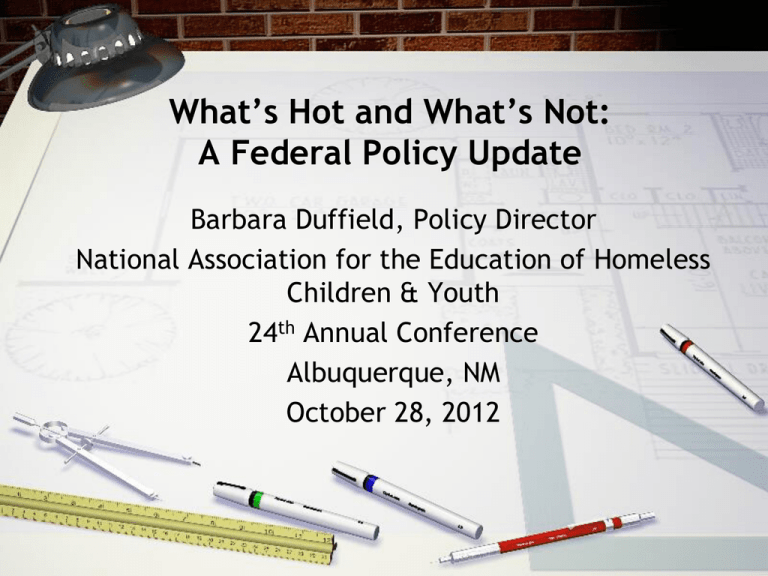
What’s Hot and What’s Not: A Federal Policy Update Barbara Duffield, Policy Director National Association for the Education of Homeless Children & Youth 24th Annual Conference Albuquerque, NM October 28, 2012 Federal Budget: Sequestration • Last year, Congress failed to reach an agreement on how to reduce the deficit by at least $1.2 trillion • As a result, 8-10% across-the-board spending cuts will take effect on January 2, 3013 unless Congress acts • This process, called sequestration, would result in a $4 billion cut for ED programs • For more info: Coalition on Human Needs www.chn.org McKinney-Vento Funding: Current Status • Six-month “Continuing Resolution” to keep government running until after the election • Current level: $65.2 million • This funding has not changed significantly in four years, while the number of homeless students in preK-12 has increased by 57% over the same time period McKinney-Vento EHCY Reauthorization: “Stand Alone” Bills • Reauthorization is the opportunity to make substantive changes to the law • March 2011: S. 571, “The Educational Success for Children and Youth Without Homes Act of 2011” introduced in U.S. Senate (Murray/Franken/Begich) • March 2011: H.R. 1253, introduced in U.S. House (Biggert/Kildee/Grijalva) McKinney-Vento EHCY Reauthorization: Status Update • US Senate: Committee passed ESEA reauthorization, including MV, in October 2011 • US House: passed piece-meal ESEA bills, including MV, in March 2012. • The fate of provisions in these bills depends on outcome of election and priorities of Administration/Congress Major Issues in M-V EHCY Reauthorization • McKinney-Vento Personnel: State Coordinators and Local Liaisons • School Stability Provisions (“Feasibility”) • Enrollment • Transportation • Disputes • Credits/Academic Support • Extra-curricular activities • Unaccompanied Youth • Preschool Children • Funding Level • Title I, Part A Setasides • Children and Youth in Foster Care McKinney-Vento Personnel: State Coordinators, Local Liaisons Issues: lack of time; lack of training; lack of resources Senate Committee ESEA bill: – Local liaisons designated by LEAs must have “sufficient training and time” to carry out their duties. – State coordinators must have “sufficient knowledge, authority, and time” to carry out their duties. House Committee ESEA bill: – – No language on liaisons State coordinators must be able to “sufficiently carry out their duties” School Selection Provisions Issues: “to the extent feasible” weakens law Senate and House Committee ESEA bills: – Presumption that school of origin is in best interest, unless • Against parent/guardian/youth wishes • Best interest determination based on student-centered factors - including the impact of mobility on achievement, education, health, and safety of homeless children and youth - weighs in favor of local enrollment – The best interest determination must prioritize the wishes of parent or youth – If the LEA determines school of origin is not in the best interest, guardian, youth: written notice/appeal must be provided Enrollment and Record Provisions Issues: barriers remain pertaining to fees and records Senate Committee ESEA bill: – Clarifies immediate enrollment, even if student owes fees or is unable to pay fees in school selected, or student has missed application or enrollment deadlines during any period of homelessness – Clarifies records must be released even if student owes fees or is not withdrawn in accordance with local procedures House Committee ESEA bill: – Clarifies immediate enrollment, even if the student has missed application or enrollment deadlines during any period of homelessness. Transportation Provisions Issues: lack of funding creates implementation problems; McKinney-Vento subgrants don’t reach all LEAs Senate and House Committee ESEA bills: – Explicitly authorize Title I Part A to be used for transportation to school of origin Academic Support, Extra-Curricular Activities Senate Committee ESEA bill (no House provisions): • States must have procedures to ensure that homeless children and youth who meet the relevant eligibility criteria are able to participate in Federal, State, or local beforeand after-school care, magnet schools, summer schools, career and technical education, advanced placement online learning opportunities, charter school programs, and relevant workforce investment programs. • SEAs and LEAs must adopt policies and practices to promote school success, including access to full participation in academic and extra-curricular activities that are made available to non-homeless students. Credit Accrual Issue: Youth lose credits due to mobility, late enrollment Senate Committee ESEA bill: • States must have procedures to ensure that homeless youth receive credit for coursework satisfactorily completed while attending a prior school and for work completed after their enrollment in a new school, consistent with State graduation requirements and accreditation standards. House Committee ESEA bill: no provisions Public Notice Senate Committee ESEA bill: Local liaisons must ensure that public notice of the educational rights of homeless children and youth is: – incorporated into documents related to residency requirements or enrollment; – provided upon school enrollment and withdrawal; – posted on the local educational agency's website; and Senate and House Committee ESEA bills – disseminated in locations frequented by parents or guardians of such children and youth, and unaccompanied youth, including schools, shelters, public libraries, and soup kitchens, in a manner and form understandable to parents and guardians of homeless children and youth, and unaccompanied youth. Privacy Senate and House Committee ESEA bills: • Schools must treat information about a homeless child or youth’s living situation as a student education record, and may not release this information to housing providers, employers, law enforcement personnel, or other persons not authorized. Senate Committee ESEA bill • Schools must pay particular attention to preventing disruption of the living situations of homeless children and youth, and supporting the safety of children and youth who are survivors of domestic violence, and unaccompanied youth. Unaccompanied homeless youth Issues: concerns about liability, FAFSA verification Senate and House Committee ESEA bills: • Requires local liaisons to ensure that unaccompanied homeless youth: – Are enrolled in school; – have opportunities to meet the same college and career ready State student academic achievement standards which other students are held (including through the credit accrual and school success provisions of the McKinney-Vento Act – Senate bill); and – are informed of their status as independent students for financial aid and receive verification for the FAFSA. • Protects school districts from liability for enrolling an unaccompanied homeless youth in accordance with the McKinneyVento Act. Preschool Children • Issues: MV’s reach is narrow; lack of capacity, fragmented nature of early childhood programming creates barriers Senate Committee ESEA bill (no House provisions): • Requires preschool programs funded, administered, or overseen by State agencies to identify and prioritize homeless preschool children for enrollment, including through reserving slots, conducting targeted outreach, waiving application deadlines, professional development, and developing the capacity to serve all homeless children Funding Senate Committee ESEA bill: • Authorizes “such sums as may be necessary” for FY2012 and each of the six successive years. House Committee ESEA bill: • Authorizes $65 million for FY2013, and increases for FY2014-2018 by a percentage equal to the percentage of inflation according to the Consumer Price Index Title I Part A: Set-asides Issues: too many “loopholes” in law; problematic interpretations from ED Senate ESEA Bill: • The setaside amount must be based on a needs assessment that includes information on child, youth and family homelessness in the LEA obtained through collaboration with other agencies, as well as the number of homeless children and youth the LEA identified the previous year. House Committee ESEA Bill: • The setaside amount may be based on a needs assessment Title I Part A: Set-asides Issues: too many “loopholes” in law; problematic interpretations from ED Senate ESEA Bill: • Specifically authorizes funds reserved for homeless children and youth under Title I to be used for local liaisons, transportation to the school of origin, services for preschool children and high school students, and removing barriers to homeless students’ enrollment, attendance, retention, and success in school. House Committee ESEA Bill: • Specifically authorizes funds reserved for homeless children and youth under Title I to be used transportation to the school of origin; for non-participating schools, may be used for removing barriers to homeless students’ enrollment, attendance, retention, and success in school. Children and Youth in Foster Care Consensus: School of origin rights and immediate enrollment for foster youth should be included in ESEA (reciprocal mandates to Fostering Connections, which requires child welfare agencies to coordinate with school districts on stability and enrollment) Controversy and conflicts: • Transportation – Is it required? Who pays? • Liaisons for foster youth – Are they required? How to ensure that this requirement doesn’t result in less time, attention, and services for homeless children and youth? Children and Youth in Foster Care Senate Committee ESEA Bill: Creates a new section of Title I Part A that: Requires State Education Agencies (SEAs) to collaborate with state child welfare agencies to ensure that: – Children and youth in foster care remain in their school of origin unless it is not in their best interest, and to be immediately enrolled in a new school if that is in their best interest; – Records are immediately transferred to a new school; – Graduation and achievement data on youth in foster care are disaggregated; and – Foster youth receive credit for work done satisfactorily in a previous school. Children and Youth in Foster Care Senate Committee ESEA Bill: • Requires SEAs to enter into an agreement with the state child welfare agency within a year of enactment to ensure that children and youth in foster care receive transportation to their schools of origin. • The agreement must describe 1) how foster care maintenance payments will be used to help fund the transportation of children in foster care to their schools of origin, and 2) how children who leave foster care will receive transportation to maintain their enrollment in their schools of origin for the remainder of the academic year, if remaining in their schools of origin is in their best interests. Children and Youth in Foster Care Senate Committee ESEA Bill: • Requires that each SEA and every LEA that receives Title I Part A funding designate an individual to serve as a point of contact for child welfare agencies. The point of contact is responsible for overseeing the implementation of the new foster care education requirements. • The foster care point of contact cannot be the McKinney-Vento homeless education coordinator, unless that individual has the capacity, resources, and time to perform both roles. • Creates a new setaside under Title I Part A for children and youth in foster care to help fund the position of LEA “point of contacts” for foster youth. Housing and Homeless Youth • Low Income Housing Tax Credit Housing • “Student Rule” – prohibits residents from living in LIHTC housing if they are full-time students • Foster youth, single mothers, parents on cash assistance are exempted from this rule • Unaccompanied homeless youth are not; forced to choose between housing and education • Congressman McDermott (D-WA) and Paulsen (R-MN) introduced legislation, H.R. 3076, that adds UHY to exemptions • Senators Franken (D-MN) and Murray (D-WA) introduced companion legislation, S. 3494, in July 2012 Child Care and Homeless Families • Barriers to child care for homeless families, include mobility, lack of paperwork, lack of outreach and identification, and fees • Without quality child care, homeless families struggle to find employment and stay homeless longer • Without quality child care, homeless children are often in substandard arrangements • Child Care Development Block Grant (CCDBG) – opportunities in reauthorization Child Care and Homeless Families • In August 2012, Senator Patty Murray (D-WA) introduced the Improving Access to Child Care for Homeless Families Act, S. 3476 The legislation: • Prioritizes homeless children for access to child care. • Allows for a homeless child to enroll in child care immediately while necessary entry documentation is obtained. • Ensures that co-pay requirements are not a barrier to child care for homeless families Child Care and Homeless Families (2) S. 3476 also: • Requires states to describe in their state child care plan how they will meet the needs of homeless families. • Requires lead agencies to coordinate with McKinney-Vento school district liaisons and other entities serving homeless families • Establishes a pilot program for increasing access to child care What is HEARTH? • The Homeless Emergency Assistance and Rapid Transition to Housing Act of 2009? • Framework for how HUD’s homeless programs will operate in foreseeable future. • New focus areas – more homelessness prevention, less emergency shelter; more permanent housing, less transitional housing. • Homeless definition slightly expanded 28 HEARTH Terms - What is a Continuum of Care (CoC)? • Government agencies, nonprofit service providers, advocates, and homeless / formerly homeless persons working together to end homelessness in a local community or in a larger rural area of a particular state. • Should you be part of the CoC? You are the voice for the kids and families you work with! Don’t assume someone else is. 29 Defining Homelessness • HUD – streets, emergency shelter, transitional housing • ED – includes staying with others or in motels because there is nowhere else to go • Under HEARTH, all who fit ED definition are considered “at risk,” and will be eligible for prevention assistance. • Under HEARTH, 3 new categories added to HUD definition; will be eligible for full range of homeless assistance. 30 HUD Definition – HEARTH Additions • People losing housing within 14 days (including staying with others, or in a motel), if no resources and no subsequent permanent place. • Families and youth defined as homeless by ED, if they have not been in permanent housing for a long time, have moved frequently, and can be expected to stay in that situation. • Individuals / families fleeing DV or other dangerous / life threatening conditions 31 HUD Definition – Regulations (1) People losing housing within 14 days (including staying with others, or in a motel), if no resources and no subsequent permanent place: • To prove this, the HUD is requiring that people provide written proof of eviction or obtain a statement from the owner or renter of the place where they are staying 32 HUD Definition – Regulations (2) People who are staying with other people are eligible for homeless assistance must prove that: 1)they moved twice in 60 days, AND 2)they did not have permanent housing for those 60 days, AND 3)that they have several conditions that would keep them without permanent housing for a long time. Each of these conditions requires verification. 33 HUD Definition – Regulations (3) People who pay to stay in motels are not eligible for homeless assistance, unless : 1)they can prove that they only have money to stay for 14 days or less, and 2)have no subsequent permanent place to go, and 3)no support networks needed to obtain other housing. 34 HR32: The Homeless Children and Youth Act • Amends HUD definition of homelessness to include children/youth verified by public schools, Head Start, IDEA Part C, and RHYA programs • Requires these children and youth and their families to be counted • www.helphomelesskidsnow.org 35 What about Head Start, USDA, and FAFSA? • Still waiting on Head Start regulations (law passed December 2007; proposed regulations on verifying eligibility and comment period closed June 2011). • Still waiting on final school meals rule; USDA issued interim rule (law passed in 2004; comment period closed October 2012). • “Application and Verification Guide” for FAFSA updated every year; no changes to unaccompanied homeless youth provisionss What is advocacy? • Dictionary definition: “The act of pleading or arguing in favor of something, such as a cause, idea, or policy; active support.” • Client and program advocacy - you do it every day! • Legislative and policy advocacy - attempt to create changes in systems and policies that impact many people Why get involved in policy advocacy? • Good policies are informed policies • No one else knows what you know - no one else is likely to take up these issues • Children and youth experiencing homelessness are invisible to the public and to policymakers • As a constituent, you have the most power to effect change Advocacy v. Lobbying • Lobbying: activities that ask legislators to take a specific position on a specific piece of legislation, or urge others to do the same (IRS definition for non-profits) • Advocacy: any activity that a person or organization undertakes to influence policy includes educating, providing information, arguing a cause What if I can’t lobby? • Check to be sure that you can’t; be mindful of the narrow, specific definition of lobbying • Find others to “make the pitch” for you, but stay engaged in general advocacy activities • Act as a private individual - you don’t lose your rights as a citizen just because you work for government Where do I begin? • It’s all about relationships! • Know who represents your community or communities and school district: www.house.gov and www.senate.gov • Make it part of your work plan to develop an ongoing relationship with at minimum of one or two Congressional offices How do I stay in the loop? • NAEHCY legislative list - give me your card, or write your email address on a piece of paper, or email me at bduffield@naehcy.org • NAEHCY web site: www.naehcy.org



